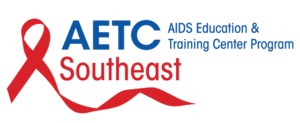
Rookie Mistakes: How to Approach Patients with HIV Who Are Isolated HBcAb Positive
By:
- Brittany Alvarez, PharmD Candidate
College of Pharmacy, Nova Southeastern University - Enisdreysis Lazo de la Vega, PharmD Candidate
College of Pharmacy, Nova Southeastern University - Elizabeth Sherman, PharmD, AAHIVP
College of Pharmacy, Nova Southeastern University
South Florida, Southeast AIDS Education and Training Center
All patients with HIV infection should be screened for hepatitis B virus (HBV) including tests for HBV surface antigen (HBsAg), HBV surface antibody (HBsAb), and HBV core antibody (HBcAb) (Figure 1). Patients seropositive for both HBcAb and HBsAb have resolved infection and do not require vaccination. The presence of HBsAb ≥ 10m IU/mL upon completion of a vaccination series symbolizes seroprotection, therefore no further vaccination is necessary. However, there remains a subset of patients seropositive for HBcAb yet seronegative for HBsAb and HBsAg – these patients are classified as isolated HBcAb pattern. This pattern can signify a false positive or it can signify the presence of infection in the past with subsequent loss of HBsAg. Opportunistic infection guidelines now provide guidance on best approaches to patients with HIV infection who are isolated core antibody positive for HBV (Figure 2).
Guideline recommendations state that if a patient is classified as having isolated HBcAb pattern they should be vaccinated with one standard dose of HBV vaccine. One to two months following vaccination their HBsAb titer should be checked. If the HBsAb is greater than 100 IU/mL then no further vaccination is necessary, but if HBsAb is less than 100 IU/mL then a complete HBV vaccine series should be completed and HBsAb titer should be checked one to two months after completion of the series.
Of note, there are multiple HBV vaccine formulations available that each differ in their dose, schedule, and level of evidence (Table 1). Two adult single-antigen HBV vaccines, Engerix-B and Recombivax HB can be given as a single or double dose. The single dose vaccine is given at 0, 1 and 6 months. The double dose vaccine is given at 0, 1, 2 and 6 months. Notably, the double dose vaccine is given as a 4-dose series. Heplisav-B is a newer, recombinant HBsAg vaccine conjugated with cytosine phosphoguanine oligonucleotide adjuvant and is given as a two-dose series – however it cannot be interchanged with any other vaccine. It is recommended that the 2-dose vaccine series only applies when both doses are Heplisav-B. Lastly, Twinrix is a combined hepatitis A and HBV vaccine given as a 3-dose series at 0, 1, and 6 months or as an accelerated regimen on days 0, 7, and 21–30 followed by a booster dose at 12 months.
In conclusion, HBV vaccination is recommended for patients living with HIV who do not have chronic HBV infection and are not immune to HBV, and in patients with isolated HBcAb. In patients with HIV, early vaccination prior to CD4 count falling below 350 cells/mm3 is recommended, however vaccination should not be deferred until CD4 reaches >350 cells/mm3 as some patients who meet this criterion do respond to vaccination.
Table 1- HBV Vaccine Schedule |
||||
| Vaccine | Dose | Schedule | Evidence Level |
Special Notes |
| Engerix-B | 20 mcg- 1 mL IM | 0, 1, and 6 months | AII | Highest level of evidence |
| Recombivax HB | 10 mcg- 1 mL IM | 0, 1, and 6 months | AII | |
| Engerix-B | 40 mcg- 2 mL IM | 0, 1, 2, and 6 months |
BI | Double dose, alternative for non-responders |
| Recombivax HB | 20 mcg- 2 mL IM | 0, 1, 2, and 6 months |
BI | Double dose, alternative for non-responders |
| Heplisav-B | 20 mcg- 0.5mL IM | 0 and 1 month | CIII | Only used when both doses given are Heplisav-B |
| Twinrix | 20 mcg- 1 mL IM | 0, 1, and 6 months or 0, 7, 21 to 30 days, and 12 months |
AII | Combined HAV and HBV vaccine |
References:
- Hepatitis A and B Vaccine | TWINRIX. https://www.twinrix.ca/en-ca/index.html. Accessed February 5, 2020.Vaccine Information Statement | Hepatitis B | VIS | CDC. https://www.cdc.gov/vaccines/hcp/vis/vis-statements/hep-b.html. Accessed February 5, 2020.
- Panel on Opportunistic Infections in Adults and Adolescents with HIV. Guidelines for the prevention and treatment of opportunistic infections in adults and adolescents with HIV:recommendations from the Centers for Disease Control and Prevention, the National Institutes of Health, and the HIV Medicine Association of the Infectious Diseases Society of America.Available at http://aidsinfo.nih.gov/contentfiles/guidelines /adult_oi.pdf. Accessed (February 6, 2020) [Pages L1-L20]
- Piroth L, Launay O, Michel ML, et al. Vaccination Against Hepatitis B Virus (HBV) in HIV1-Infected Patients With Isolated Anti-HBV Core Antibody: The ANRS HB EP03 CISOVAC Prospective Study. J Infect Dis. 2016.
- Terrault NA, Lok ASF, McMahon BJ, et al. Update on prevention, diagnosis, and treatment of chronic hepatitis B: AASLD 2018 hepatitis B guidance. Hepatology. 2018;67(4):1560-1599. doi:10.1002/hep.29800


